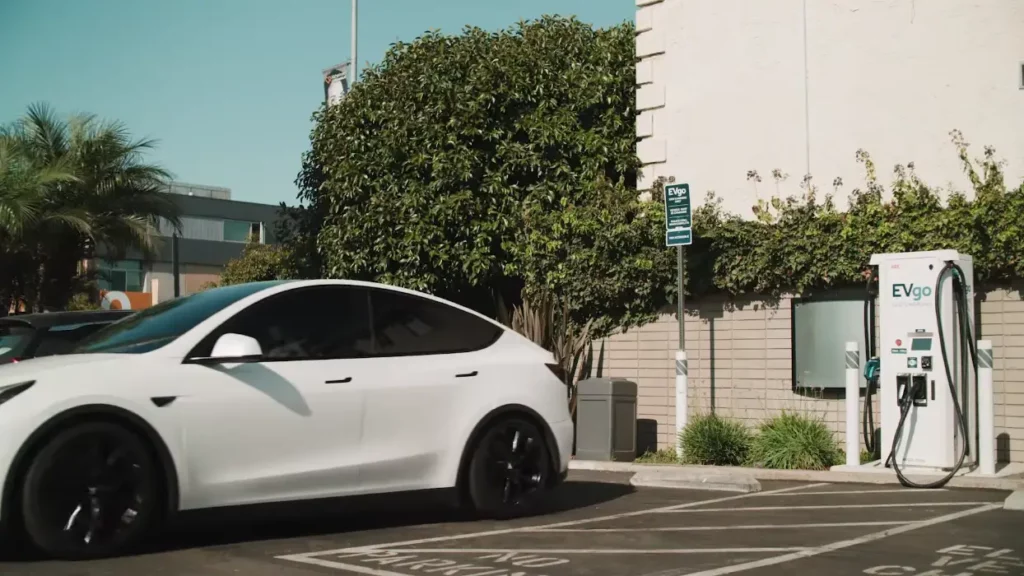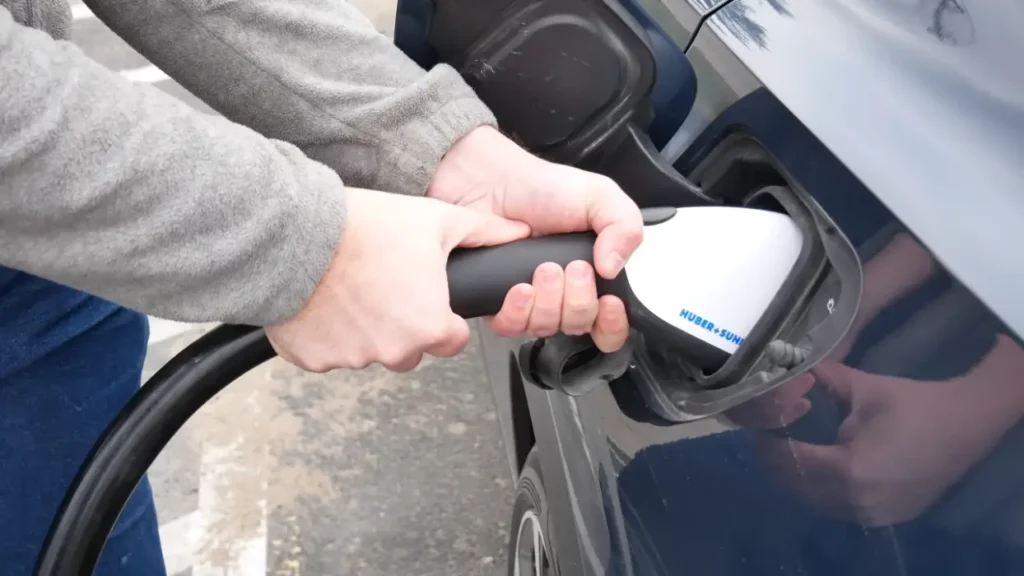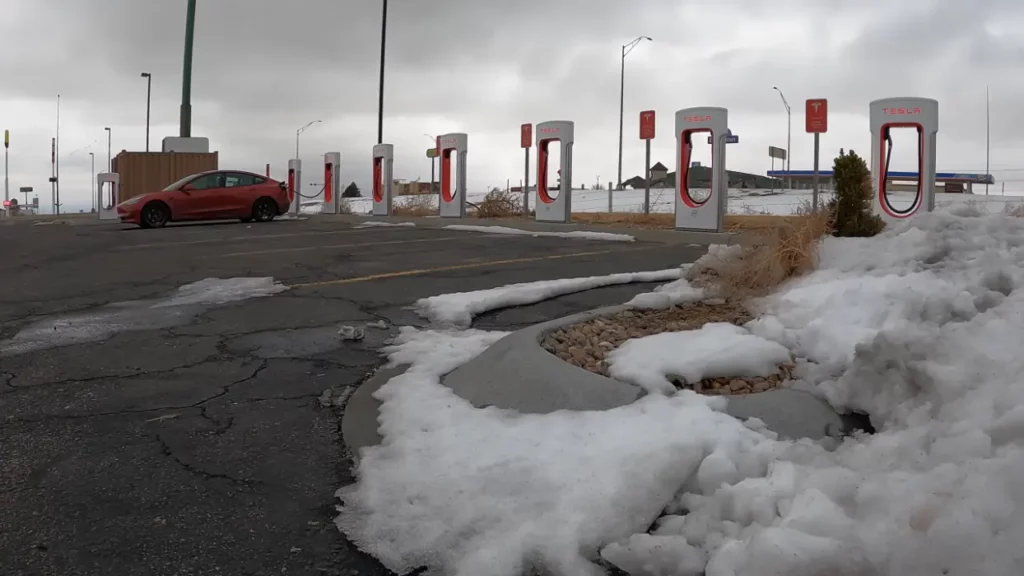Using a Tesla supercharger is the best and quickest way to charge your Tesla, especially if you are on long trips. However, there have been some debates and concerns regarding “is supercharger bad for tesla?” and their potential negative impact on Tesla cars.
Quick Glance:
- Tesla Superchargers are 480-volt DC, which provides approximately 200 miles of range in roughly 15 minutes.
- By 2023, Tesla has reached a new milestone with over 45,000 Supercharger stalls globally (33% growth over the years).
- On 15th March 2023, Tesla revealed its first V4 supercharger stalls in the Netherlands.
- Too frequent supercharging, charging in extreme weather conditions, charging at too low or high levels of current, and frequently charging at non-Tesla Supercharger can damage your Tesla battery.
Firstly, supercharger is not that bad for tesla but it is also not the ideal charging method for charging your Tesla EV daily.

What Is the Tesla Supercharger?
A 480-Volt (DC) fast charging option for Tesla customers to charge their electric vehicles designed by Tesla. This high-powered rapid charging station can cover up to 200 miles of distance within approx. 15 to 30 minutes (depending on Models).
A supercharger allows owners to recharge their car’s battery in a very short amount of time. This provides them with more ease and independence when traveling long distances.
Tesla Supercharger also incorporates advanced safety features. These include:
- Thermal management systems to maintain optimal charging temperatures,
- Prevents or protects against overcharging, and
- Continuous monitoring of the charging session to ensure reliability and vehicle longevity.

Types of Superchargers Available:
Tesla introduced its first-generation supercharger in 2012, also known as the “V1 Supercharger.” With only up to 120 kW charging speed, V1 Superchargers were compatible with Tesla’s Model S and Model X.
Soon after the breakthrough, Tesla launched two more versions of their Supercharger, which are referred to as “V2” and “V3” over the years. Recently in 2023, Tesla introduced its newly developed supercharger version “V4”.
Here’s a rundown of Tesla’s four versions of dedicated Superchargers for charging its EVs:
How Does the Tesla Supercharger Work?
It is a simple straightforward operating process. As the owner/driver connects their car’s charging port to a Supercharging station, the robust connector of the charger securely establishes a reliable connection with the vehicle’s charging port.
Tesla’s charging system then signals the vehicle to initiate the charging process and the charging station starts delivering a high-power DC charge to the vehicle.
Unlike traditional charging methods that rely on AC (Alternating Current) power, the Tesla Supercharger’s DC (Direct Current) power delivery minimizes energy losses and ensures faster charging times.
Each supercharger has many charging stalls so that multiple vehicles can be charged at the same time to increase accessibility and reduce wait times for Tesla customers.
Where Can I Find a Tesla Supercharger?
Watch this video for clear and more practical understanding.
Is a Supercharger Bad for Tesla EVs?
The Tesla supercharger itself is not designed to negatively affect or harm your car’s battery. But it is also not the ideal charging method for charging your Tesla EV daily.
Tesla has recently published its “Impact Report 2022” where Tesla claims that its electric vehicles only lose around 12% after about 2,00,000 miles. A newly published “Impacts of Fast Charging” study by Recurrentauto.com also states that frequent charging at the Supercharger station does not accelerate the battery degradation of Tesla EVs.
According to that study, the Recurrentauto.com team took a total of 12,500 Tesla EVs from the USA.
The study focused on and analyzed the data between cars that charge 90% of the time at Superchargers and cars that charge 10% of the time at those stations.
The result clearly shows that there’s no statistically notable difference in battery degradation between frequent and rare fast charging. This actually supports Tesla’s claim.
However, the study also emphasizes the fact that “occasional use of fast charging at Supercharger is fine” because there is still the possibility that Supercharging may sometimes negatively impact your car’s battery.
Related Post: Tesla High-Usage Supercharger Station: A Complete Guide
When Is a Supercharger Bad for Your Tesla?
There are several situations when you should avoid using a Supercharger without ensuring proper precautional measures:
Intense or Extreme Heat:
Tesla EVs are equipped with Li-ion batteries, but these batteries are not designed for extreme weather conditions.
Since the Supercharger generates higher heat to fast charge the vehicle, avoid charging your car with a supercharger without preconditioning it in intense hot temperatures.
Pre-conditioning your car simply means the internal Thermal Management System of your Tesla will automatically use the AC to pre-cool it before charging if the temperature is over 100F.
Otherwise, if you let your car run the internal AC during the charging task, it will take longer time to charge than usual since the system has to maintain the Li-ion battery at a certain temperature.
Even running the AC during charging may strain your car battery.
Extremely Cold or Freezing Temperature:
Similarly, charging your car at a supercharger station during extreme or intense cold weather can also be damaging or may cause lithium plating.

In such circumstances, you should also pre-condition your Tesla before charging.
Otherwise, the ionizing liquids of the internal Li-ion battery can freeze as well, and the onboard computer will limit or prohibit charging to prevent damage.
You can drive your car a little bit before charging to warm it up or allow the Supercharger to navigate your car. You can even get 25% faster charging when your car’s battery is pre-conditioned.
When fast-charging your car, avoid charging at too low or too high a level of charge because the battery resistance will be increased.
Using Non-Tesla or Third-party Supercharger:
Even though Tesla dominates the market by providing the maximum number of Supercharger stations globally (approximately over 45,000+ stations), the number of third-party Supercharging stations and non-Tesla fast-charging stations is rapidly increasing too.
The battery degradation rate is much higher when you continuously charge your Tesla car at non-Tesla Superchargers, like Electrify America.
There’s a high possibility that the “Active Thermal Management System” of your car may not kick in since you’re using a non-Tesla supercharger.
Thus, if you use the charger for a prolonged period while the TMS may not be working correctly, it will cause your car’s lithium battery to overheat. This will cause degradation and a significant drop in battery capacity.
Related Post: Take Care of Your Tesla Emergency Charge Like A Pro!
Frequently Asked Questions [FAQs]
How dependable are Tesla Superchargers?
Whether it’s Ford Motors, Rivian, General Motors, or Volvo Cars, Tesla’s Supercharging network is significantly more reliable and efficient than its competitors.
Is it safe to supercharge my Tesla?
Yes, it is safe. Based on Recurrent’s current study report, occasional charging at the Supercharger will have no significant impact on the battery degradation of Tesla EVs.
Is it bad to charge my Tesla to 100% at a supercharger?
Yes, absolutely. If you really want the full range, you can charge your car up to (90 – 95) % but you should not charge it to 100% because it will reduce the longevity of your Tesla battery.
Is it true that Tesla superchargers are always free?
Only Tesla Model S and Model X owners with an active unlimited free Supercharging plan are now entitled to six years of free Supercharging.
However, owners have to trade in or remove the limitless Supercharging plan from their car and purchase a new Model S or Model X by the 30th of June 2023.
What is the cost of charging a Tesla for a supercharger?
The cost of Tesla supercharging ranges from $0.25 to $0.50 per kilowatt-hour depending on where you are.
It normally costs roughly $25 to fully charge a Tesla using a Supercharger. The Supercharger network charges more for non-Tesla drivers, about 77 (pounds) per kWh.
Related Post: Does All Tesla Come with J1772 Adapters?
